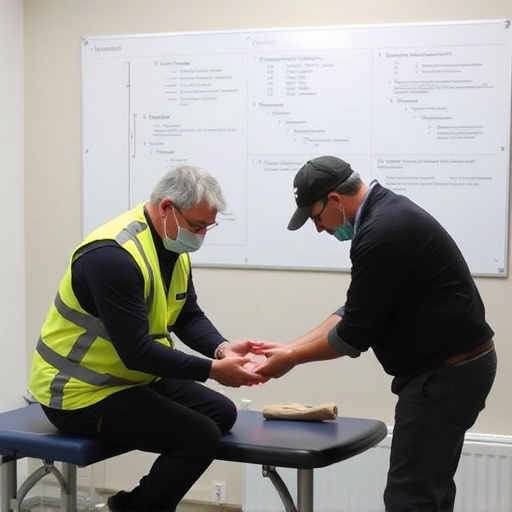Repetitive Strain Injury (RSI) is a common yet often missed health issue affecting daily life and work performance globally. Caused by sustained or repeated tasks, RSI can lead to symptoms from mild discomfort to severe disability, including carpal tunnel syndrome, tendinitis, epicondylitis, chronic pain, reduced mobility, and sciatica. Effective management involves understanding causes, preventing re-injury through ergonomic adjustments, regular breaks, physical therapy, and tailored exercises. With strategic planning and professional guidance, individuals can safely return to work while mitigating RSI risk.
Returning to work after a repetitive strain injury (RSI) can be challenging, but with careful planning and support, it’s possible. This comprehensive guide explores strategies for a safe and successful return, focusing on understanding RSI and its impact, implementing effective work-related adjustments, and creating a supportive workspace. By following these steps, individuals can manage symptoms, maintain long-term health, and embrace a sustainable career path despite the injury.
- Understanding Repetitive Strain Injury (RSI) and Its Impact
- Strategies for a Safe Return to Work
- Creating a Supportive Workspace and Maintaining Long-Term Health
Understanding Repetitive Strain Injury (RSI) and Its Impact

Repetitive Strain Injury (RSI) is a common yet often overlooked condition that affects millions of people worldwide. It arises from prolonged or repetitive tasks, leading to pain, discomfort, and potential long-term damage in muscles, tendons, and nerves. RSI can manifest in various ways, such as carpal tunnel syndrome, tendinitis, and epicondylitis, with symptoms ranging from mild tingling to severe debilitation. The impact of RSI extends beyond physical discomfort; it can significantly affect daily life, work performance, and overall quality of life.
Chronic pain, reduced mobility, and even sciatica relief challenges are common consequences. In the context of returning to work, understanding RSI’s causes and effects is crucial. This knowledge enables individuals to implement preventive measures and seek appropriate chiropractic care or treatment plans to manage symptoms effectively. With the right approach, it’s possible to safely transition back to work while minimizing the risk of RSI exacerbation.
Strategies for a Safe Return to Work

Returning to work after a repetitive strain injury (RSI) requires careful planning and strategic steps to ensure a safe and smooth transition. The first crucial step is to consult with medical professionals, including your doctor or a specialist in auto accident recovery and physical therapy. They can provide guidance tailored to your specific condition, offering insights on the best approach for your return to work. This might include recommendations for modifications in your work environment or tasks to reduce strain.
Additionally, regular sessions with a physical therapist can be invaluable. Spinal adjustments and targeted exercises can help strengthen muscles, improve flexibility, and alleviate symptoms associated with RSI. Gradually reintroducing physical activities and maintaining a consistent self-care routine will play a significant role in your recovery. It’s essential to listen to your body and adjust your pace accordingly to prevent setbacks.
Creating a Supportive Workspace and Maintaining Long-Term Health

Returning to work after a repetitive strain injury (RSI) requires not just healing but also transforming your workspace into a supportive environment. This includes ergonomically rearranging your station, using tools and equipment designed for comfort, and incorporating regular breaks into your routine. A well-designed workspace can significantly reduce the risk of re-injury by alleviating physical stress.
Long-term health depends on continuing good practices even after you’ve recovered. Engaging in non-invasive treatments like physical therapy and massage can help maintain flexibility and strength. Functional rehabilitation exercises, tailored to your specific needs, can prevent future strain. Regular check-ins with healthcare professionals ensure ongoing post-injury care, allowing you to stay active while managing any discomfort or pain effectively.
Returning to work after repetitive strain injury (RSI) requires a thoughtful, gradual approach. By understanding RSI’s impact and implementing strategies for a safe return, you can create a supportive workspace that promotes long-term health. Remember, it’s crucial to listen to your body, seek professional guidance, and make adjustments as needed to ensure a successful transition back to the workplace.














